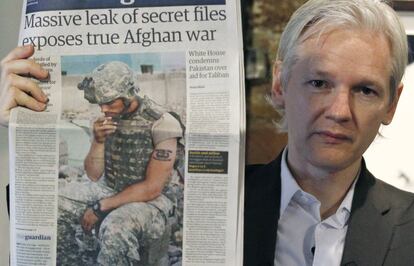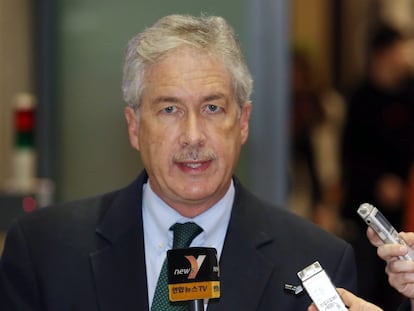When WikiLeaks and Assange entered the newsroom: A basement, thousands of documents and hours of research
The publication in 2010 by five media outlets of thousands of US diplomatic cables opened the door to a new form of collaborative journalism. EL PAÍS reviews what it was like to participate in that project

Some of the journalists who, in late 2010, worked with the largest leak of documents that EL PAÍS had ever had access to did not even know that there was a basement in the newspaper’s headquarters in Madrid. On November 1 of that year, the eccentric Australian editor Julian Assange, co-founder of WikiLeaks, had invited the Spanish newspaper to join The Guardian, The New York Times, Le Monde and Der Spiegel in a massive investigation involving thousands of U.S. diplomatic cables. Three floors below the ground floor of the newsroom, a team with dozens of reporters was set up, many of whom were called in from their desks halfway across the world without even knowing what they were about to face.
The team had to race against the clock to unravel some of the secrets of American foreign policy before the November 28 publication date. What took place during those days was an unparalleled global collaborative effort between journalists and media outlets. The WikiLeaks phenomenon, in the news again due to the release of Julian Assange following a plea deal with the United States Department of Justice by which the former hacker accepts that he violated the law, was a turning point for a new era of leaks and investigative journalism.
The material that WikiLeaks made available to these newspapers, and for which Washington has been persecuting Assange for over a decade, was of such import that it required the creation of mechanisms to guarantee the total confidentiality of the project. Nobody, either outside or inside that basement, could know what it was about. The documents, more than 250,000 cables from the State Department, could only be worked on in that room and never go beyond its doors. Communication with the team led by Assange, then 39 years old, was done through an encrypted messaging system. It was a method that some newsrooms were not used to at the time, but which more than 13 years later is handled more naturally.
EL PAÍS was the last of the five media outlets involved to receive the documents. The challenge, in just a few weeks, was enormous. The project required a technical team so that those thousands of plain text files, the cables, would be manageable to reporters. The newsrooms had to deal with the pressure and versions of events of the party involved, the Barack Obama Administration. The WikiLeaks site was also a victim of computer hacking. Finally, a distribution error caused some copies of the German magazine Der Spiegel to be distributed to newsstands ahead of time. The launch date had to be brought forward.
Research on the internet
By 7 p.m., the information that has kept Assange behind bars for the last few years was out in the open. It involved espionage, hidden maneuvers and corruption; it mentioned leaders such as Russia’s Vladimir Putin, Venezuela’s Hugo Chávez, Iran’s Mahmoud Ahmadinejad, France’s Nicolas Sarkozy, China’s Hu Jintao, Italy’s Silvio Berlusconi, Germany’s Angela Merkel... The leak also set another precedent: a historical news exclusive was being published online first, before going out in print. The internet was the natural habitat of Assange, an editor, journalist and hacker, and that was where many of his leaks hit first.
It was neither WikiLeaks’ first nor its last success. The website created in 2006 by Assange and the man who was then his closest collaborator, the German cyberactivist Daniel Schmitt (a pseudonym for Daniel Domscheit-Berg), had already aired thousands of U.S. documents about the wars in Iraq and Afghanistan. In April 2010, a few months before Assange shared the diplomatic cables, his website published a video recorded by a U.S. helicopter during an attack in Baghdad in which 11 Iraqis were killed, including a photographer from the Reuters agency. A year after this, EL PAÍS was once again a participant in a new leak, in this case, of more than 700 files on the Guantánamo prison.
The information artillery that WikiLeaks was handling was already directly proportional to the shadows that were beginning to surround the figure of Assange. One of the work maxims in what was known as Cablegate, subscribed to by the five newspapers, was to protect the safety of the people mentioned in the documents, in case publishing their name posed a risk. That’s how it was done. However, almost a year after the publication of the State Department cables, in September 2011, the Australian editor decided to publish all the cables without protecting the sources. The five media organizations that had received the leak signed a statement condemning this move, in what was a first crack in the collaboration between Assange and the press.
Meanwhile, the judicial persecution against Assange began. First there were two accusations of sexual assault in Sweden and, later, an espionage case against him was opened in the United States. Some of Assange’s closest collaborators, such as Domscheit-Berg or the Icelanders Birgitta Jónsdottir and Herbert Snorrason, quit the project due to disagreements with him. EL PAÍS was in contact with all three during those years. Although they did not agree with Assange’s management — Domscheit-Berg and Snorrason launched a new project of their own, OpenLeaks, without success — they always condemned the judicial crusade against him.
The work done in 2010 by these five newspapers served, at least, two purposes: first, to once again open the door to the so-called whistleblowers, informants who, like the soldier Chelsea Manning, who was at the origin of this leak, want to air the illicit activities of the organizations for which they work. The European Union approved a directive for the protection of these individuals at the end of 2019.
Second, Cablegate launched a new era of collaborative journalism between large media outlets that would normally be competitors, to work together on investigative projects. Manning was followed in 2013 by Edward Snowden, a former U.S. contractor for the National Security Agency who leaked information about the U.S. global surveillance program to the newspapers The Guardian and The Washington Post. Three years later, another media alliance published the so-called Panama Papers based on documents from a Panamanian law firm specialized in tax havens. The analysis of this leak counted on the collaboration of the International Consortium of Investigative Journalists (ICIJ).
In 2021, the ICIJ coordinated, with the collaboration of a team from EL PAÍS and journalists from 17 countries, the investigation of a leak of 11.9 million internal files on opaque taxation, the Pandora Papers, one of the best examples to date of this new scenario of leaks and investigations with which WikiLeaks and Assange shook journalism in November 2010, from the basement of the newsroom to the entire world.
Sign up for our weekly newsletter to get more English-language news coverage from EL PAÍS USA Edition
Tu suscripción se está usando en otro dispositivo
¿Quieres añadir otro usuario a tu suscripción?
Si continúas leyendo en este dispositivo, no se podrá leer en el otro.
FlechaTu suscripción se está usando en otro dispositivo y solo puedes acceder a EL PAÍS desde un dispositivo a la vez.
Si quieres compartir tu cuenta, cambia tu suscripción a la modalidad Premium, así podrás añadir otro usuario. Cada uno accederá con su propia cuenta de email, lo que os permitirá personalizar vuestra experiencia en EL PAÍS.
¿Tienes una suscripción de empresa? Accede aquí para contratar más cuentas.
En el caso de no saber quién está usando tu cuenta, te recomendamos cambiar tu contraseña aquí.
Si decides continuar compartiendo tu cuenta, este mensaje se mostrará en tu dispositivo y en el de la otra persona que está usando tu cuenta de forma indefinida, afectando a tu experiencia de lectura. Puedes consultar aquí los términos y condiciones de la suscripción digital.
More information
Archived In
Últimas noticias
Most viewed
- Sinaloa Cartel war is taking its toll on Los Chapitos
- Oona Chaplin: ‘I told James Cameron that I was living in a treehouse and starting a permaculture project with a friend’
- Reinhard Genzel, Nobel laureate in physics: ‘One-minute videos will never give you the truth’
- Why the price of coffee has skyrocketed: from Brazilian plantations to specialty coffee houses
- Silver prices are going crazy: This is what’s fueling the rally











































